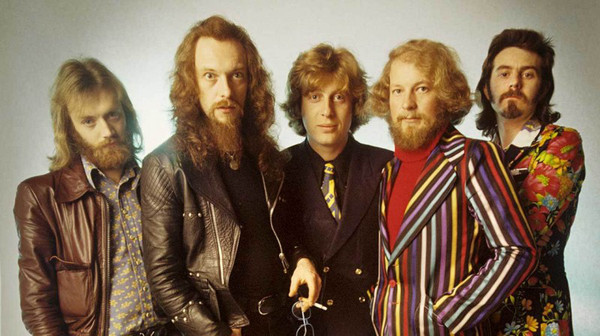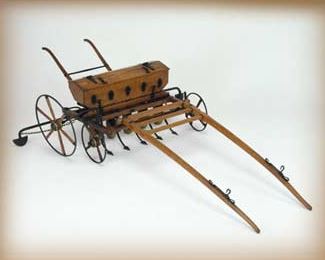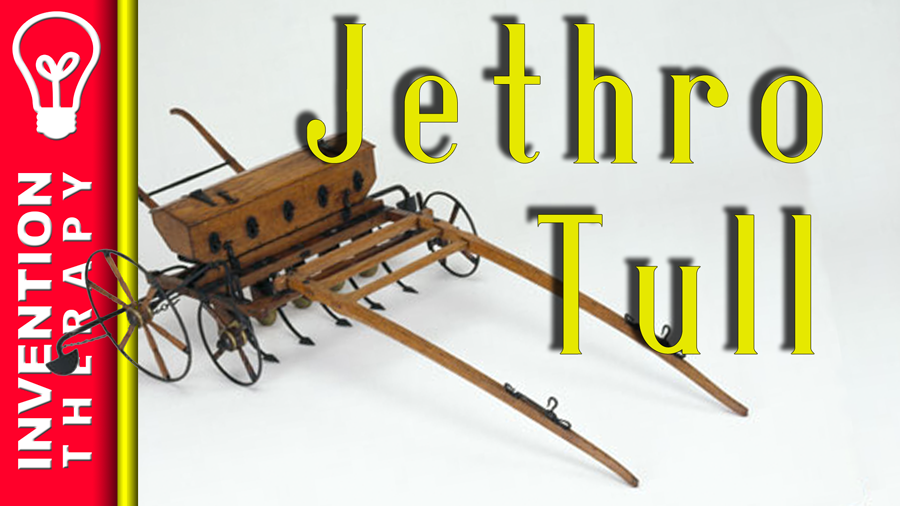The band received their name from their booking agent who was a history buff. You will learn from this article how the name “Jethro Tull” influenced us in both music and agriculture.
When you hear the name Jethro Tull, you probably think about the British rock band from the 20th century. But the name of the group stems from a British inventor from the 18th century whose invention was so significant and influential that it sparked an agricultural revolution. In this article, we are talking about Jethro Tull, the British inventor and a farming pioneer from Berkshire, England.

Jethro Tull invented a seeding drill, an innovation that would prove to be essential for the agricultural revolution in England. The seeding drill, in turn, was also an influence for the Industrial Revolution at the end of the 18th century. The agricultural revolution allowed for more productivity and would create an abundance of food, which would drastically improve the living conditions in England. The improved lifestyle was the perfect breeding ground for the Industrial Revolution.

Long before the band, the seed drill was designed by Jethro Tull for practicality and more productivity relatively early in his life when working at his father’s farm. Tull’s analytical mind and his willingness to look for ways to improve tools were vital for this invention.
Jethro Tull’s Life
Let us dive deeper into the life of Jethro Tull and learn how he invented the seed drill and the other inventions that followed. The seed drill might seem like an ordinary thing today; it was very revolutionary in Tull’s time.
Younger days
Jethro Tull was born to a well-off family from Basildon, Berkshire. He was born in 1674 to Jethro Tull Sr. and Dorothy. Jethro’s father was keen for his son to get a good education and to become an influential personality. In his early childhood, Jethro would receive elementary education at home, where he learned how to read and write. Jethro was a quick learner and an intelligent child, so his father had big plans for him.
The financial situation of the family would allow Jethro to get a good education from a very reputable college. Jethro Tull Jr. would enter the St. John’s College in Oxford, where he would study law. But he did not obtain any degree at the college. Due to his health problems, Jethro withdrew from the college. He later became a part of the Staple Inn and the Gray’s Inn, where he studied to become a barrister. His health problems got to him, and Tull abandoned the idea of becoming a barrister altogether.
Tull returned to his father’s farm. He would go on to marry Susanna Smith, and they settled on the farm of Jethro Tull Sr. The couple had three children: two daughters and a son.
Tull’s Invention of the Seed Drill
Upon returning to his father’s farm, Tull junior had the chance to work on his ideas and prototypes for improving cultivating machinery. He was more and more interested in agriculture and helped his father around his farm.
Tull started working on the prototype of the seed drill between the years of 1699 and 1701. The demand for produce was increasing, but the cultivating methods were inefficient and not capable of covering the need. Tull and his father had a problem on their hands. They knew that the process of sowing the seeds was the biggest problem, and Tull saw plenty of potential for improvement. His first idea for the seed drill came in 1699, but it was still not the final solution.
Tull became frustrated with his workers and was often very demanding of them. He wanted them to sew the seeds at precise spaces between the grains and instructed them to sow the seeds at a lower density. There was unrest brewing among the workers, and the solution for the demand was still not solved. Tull was determined to create the seed drill, which he hoped would be the solution to the problem. He started working on it, incorporating ideas and experimenting.
He finally succeeded in 1701. That was the year when the first successful seed drill was produced and proved to be effective. The Tull family wanted to incorporate seed drills to their farm, which would increase the productivity to meet the demands. The seed drill was met with disgust by the workers – they knew that it threatened their working places, and there were many protests against it. Tull had difficulties with importing his innovation to his farm.
How Did the Seed Drill Work?
It was a simple but effective solution that would prove to be essential for agriculture for centuries to come. Tull’s seed drill used a rotating cylinder to sort out the seeds and distribute them evenly over the field. The cylinder scattered seeds into channels that were made by the plow. The plow was mounted at the front of the device. These channels were then covered by a harrow that was installed at the back of the seed drill. A harrow is a large, metal device with teeth that drags over plowed land to break up dirt, remove weeds, and cover the seeds. The harrow increased productivity, reduced the need for more workers, and sowed seeds at appropriate distances.

While the drill did gain some traction in the agricultural world at the start, it was still not accessible due to its high price and unreliability. The device still needed to be improved. Tull had to think of a way that it could be operated by horsepower. The durability and reliability of the sowing pattern also needed improving.
Jethro Tull Jr. managed to make enough money to purchase a farm for himself and start working on improvements for the seed drill. He bought the Prosperous Farm in Hungerford in 1709, where he would create the perfect environment for experiments and making improvements to the seed drill. He had many servants and helpers to help him conduct experiments. But this process came to a halt when Tull’s health problems started. He had a pulmonary disease that would stop him from making further improvements to the drill.
Tull’s Odyssey in Europe
Tull Jr. was frustrated with his health problems, so he traveled to Europe to find a cure for his disease. This travel occurred two years after he settled at the Prosperous Farm – in 1711. This trip was funded through some of his earnings as the inventor of the seed drill. He was very much interested in agriculture in Europe and wanted to compare some of the practices to those exhibited back home. The Enlightenment Age inspired Tull, and he took a more scientific approach to agricultural practices in Europe.
Instead of searching for a cure, Tull became more and more engrossed in the farming practices in Europe. He mainly explored France; he spent a considerable amount of time in Montpellier in the south of France but explored some other areas of Southern Europe. It was his analytical mind and scientific approach that would allow Tull to come to some interesting conclusions. He meant that the cultivating practices in the south of France were more advanced than in England.
At first, he was particularly interested in vineyard cultivation. Tull was somewhat against using manure for cultivating and was a proponent of pulverizing the soil to make it more fertile. Tull already had some ideas for making improvements to agricultural practices, and they were only encouraged when he was in France. He saw that some of the farmers were already using some methods that were similar to his horse-hoe idea. It was this trip to Europe that inspired Tull to make improvements on his farm. Instead of searching for a cure for his pulmonary disease, Tull got the inspiration for inventions that would change agriculture forever.
Further Inventions
Inspired by his trip to France, Tull was determined to incorporate some of his ideas agriculture on his farm. Along with the seed drill, it was these improvements and inventions that were very important for changing agriculture in England.
Pulverized Soil
Contrary to popular belief, Tull opposed the idea of using horse manure to make the soil more fertile. He theorized that fertilizer is not efficient for making fertile soil and that a more efficient way would be to pulverize the soil. He saw farmers use this practice in French vineyards and got a confirmation of his belief, which was with him even before he went to France. Tull knew that manure doesn’t provide enough nutrients for the plants to grow. Pulverized soil is the best solution as it would offer more earth for the plants to feed.
Improvements to the Seed Drill
On his farm, Tull wanted to perfect the seed drill to make it more viable for mass production. Firstly, he made it possible for the machine to be drawn by a horse, which neglected the need for a worker to operate it. To achieve this, he had to install wheels to the drill for it to move.
An even more remarkable achievement was that he made it possible for the drill to sow seeds in three different rows instead of a singular row. This invention managed to increase productivity significantly. He later expanded the viability of the plow by incorporating his hoe, which made the seed drill more reliable and more effective.
Horse-Drawn Hoe
His next invention would be the horse-drawn hoe, which was an improvement over existing plows. He would continue to work with horse-drawn hoes until his late life.
His horse-drawn hoe was a significant achievement for the agricultural industry. His newest plow was designed so that the blades were able to dig out roots and grasses from the ground. They were then tossed to the side to let them dry. Tull’s hoe improved the quality of the cultivated soil significantly.
In 1731, Jethro Tull wrote the book “Horse Hoeing Husbandry” where he explained all of his inventions and implementations. From then on, his designs started becoming more and more popular.
Tull’s Legacy
During his lifetime, Tull was often ridiculed by peers and agriculturers around England. His improvements and inventions were often not well received by the people due to the high prices and design that was not yet viable for mass production.
Eventually, other farmers around England saw the need to increase their productivity. This need forced them to look to new inventions and implementations, and that is when Tull’s inventions started to gain traction. His devices gained popularity later in the 18th century and the 19th century. It was due to his achievements that cultivating methods improved massively in England, leading to the agricultural revolution. These advancements later made the Industrial Revolution possible.
Tull was very much the first one to start dealing with agricultural machinery. He is often seen as a pioneer in agrarian improvement during the 18th century. But his inventions were not received warmly by everyone. They were opposed by the workers who feared for their jobs but were endorsed by larger companies, big landowners, and agricultural barons. His inventions were debated around the world.
We can credit Tull with moving the agriculture industry in a positive direction. He invented seed drills, horse-drawn hoes, and improved plows. He popularized the practice of pulverizing the soil.
What Can We Learn From Jethro Tull?
There is something satisfying about reading about these early inventors because we can incorporate many of their ideas and learnings from their lifetime to modern times. These first inventions were convenient and groundbreaking.
One idea we can learn is to broaden your horizons and research the market. Jethro Tull went to France to see another perspective on agriculture, and it was there where he gained valuable knowledge that enabled his inventions.
Sometimes, keeping things simple works best. Tull saw potential in practical ideas to increase productivity. The seeding drill was a pretty simple invention, but crucial nonetheless.
Finally, believe in your ideas if you think they are right. During Tull’s lifetime, many people ridiculed him, and workers opposed the inventions as well. He stayed determined and started reaping the rewards later in his life.

Are you ready to become an inventor?
Getting your idea out of your head and into your hands is only the first in a long set of steps towards becoming a successful inventor.

First Steps To A Successful Invention
At Invention Therapy, we believe that the power of the internet makes it easier than you think to turn your invention idea into a reality. In most cases, you can build a prototype and start manufacturing a product on your own. Changing your way of thinking can be difficult. Being an inventor requires you to balance your passion with the reality of having to sell your products for a profit. After all, if we can't make a profit, we won't be able to keep the lights on and continue to invent more amazing things!Please subscribe to our Youtube Channel!




